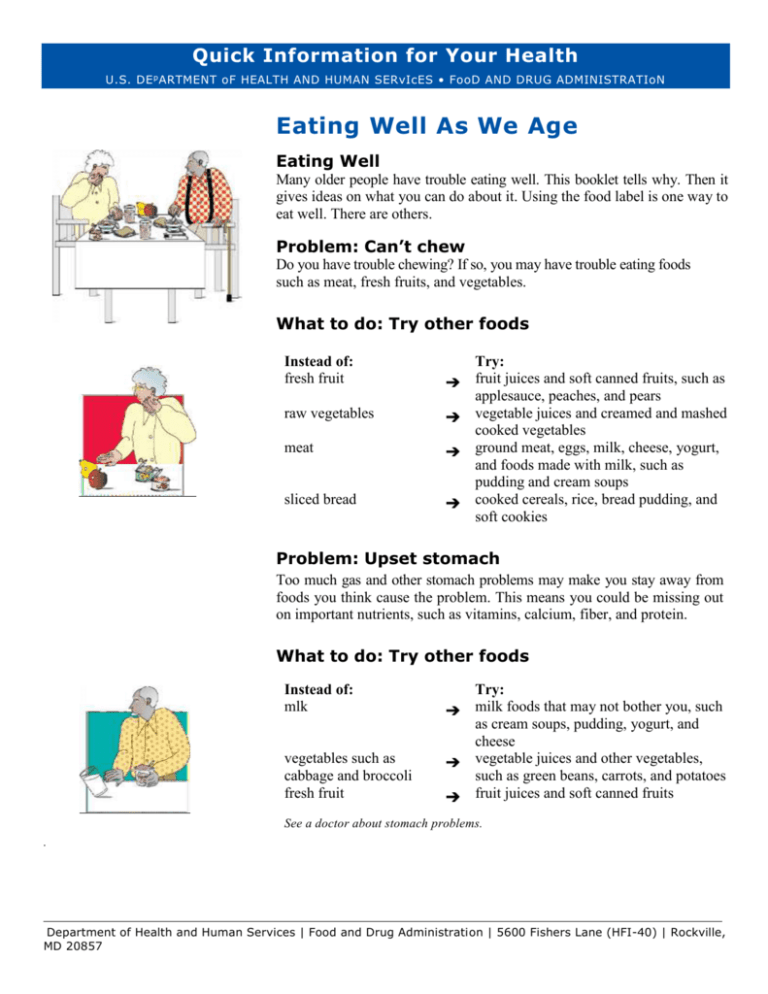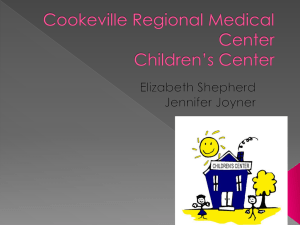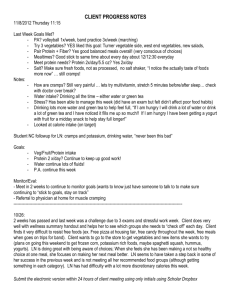Eating Well
advertisement

Quick Information for Your Health U.S. DE p ARTMENT oF HEALTH AND HUMAN SERvIcES • FooD AND DRUG ADMINISTRATIoN Eating Well As We Age Eating Well Many older people have trouble eating well. This booklet tells why. Then it gives ideas on what you can do about it. Using the food label is one way to eat well. There are others. Problem: Can’t chew Do you have trouble chewing? If so, you may have trouble eating foods such as meat, fresh fruits, and vegetables. What to do: Try other foods Instead of: fresh fruit raw vegetables meat sliced bread Try: fruit juices and soft canned fruits, such as applesauce, peaches, and pears vegetable juices and creamed and mashed cooked vegetables ground meat, eggs, milk, cheese, yogurt, and foods made with milk, such as pudding and cream soups cooked cereals, rice, bread pudding, and soft cookies Problem: Upset stomach Too much gas and other stomach problems may make you stay away from foods you think cause the problem. This means you could be missing out on important nutrients, such as vitamins, calcium, fiber, and protein. What to do: Try other foods Instead of: mlk vegetables such as cabbage and broccoli fresh fruit Try: milk foods that may not bother you, such as cream soups, pudding, yogurt, and cheese vegetable juices and other vegetables, such as green beans, carrots, and potatoes fruit juices and soft canned fruits See a doctor about stomach problems. . Department of Health and Human Services | Food and Drug Administration | 5600 Fishers Lane (HFI-40) | Rockville, MD 20857 Problem: Can’t shop You may have problems shopping for food. Maybe you can’t drive anymore. You may have trouble walking or standing for a long time. What to do: Ask the local food store to bring groceries to your home. Some stores deliver free. Sometimes there is a charge. Ask your church or synagogue for volunteer help. Or sign up for help with a local volunteer center. Ask a family member or neighbor to shop for you. Or pay someone to do it. Some companies let you hire home health workers for a few hours a week. These workers may shop for you, and do other things. Look for these companies in the Yellow Pages of the phone book under “Home Health Services.” Problem: Can’t cook You may have problems with cooking. It may be hard for you to hold cooking utensils and pots and pans. Or you may have trouble standing for a long time. What to do: Use a microwave oven to cook TV dinners, other frozen foods, and foods made up ahead of time by the store. Take part in group meal programs, offered through senior citizen programs. Or have meals brought to your home. Move to a place where someone else will cook, such as a family member’s home or a home for senior citizens. To find out about senior citizen group meals and home-delivered meals, call (800) 677-1116. These meals cost little or no money. Problem: No appetite Older people who live alone sometimes feel lonely at mealtimes. This feeling can make you lose your appetite. Or you may not feel like making meals for just yourself. Maybe your food has no flavor or tastes bad. This could be caused by medicines you are taking. What to do: Eat with family and friends. Take part in group meal programs, offered through senior citizen programs. Ask your doctor if your medicines could be causing appetite or taste problems. If so, ask about changing medicines. Increase the flavor of food by adding spices and herbs. Problem: Short on money Not having enough money to buy enough food can keep you from eating well. Department of Health and Human Services | Food and Drug Administration | 5600 Fishers Lane (HFI-40) | Rockville, MD 20857 What to do: Buy low-cost food, such as dried beans and peas, rice, and pasta. Or buy food that contain items, such as split pea soup, canned beans, and rice. Use coupons for money off on foods you like. Buy foods on sale. Also buy store-brand foods. They often cost less. Find out if your local church or synagogue offers free or low-cost meals. Take part in group meal programs, offered through local senior citizen programs. Or have meals brought to your home. Get food stamps. Call the food stamp office listed under your county government in the blue pages of the phone book. Read Food Labels Look for words that say something healthy about the food. Examples are: “Low Fat,” “Cholesterol Free,” and “Good Source of Fiber.” Also look for words that tell about the relation of food to a disease. A low-fat food may say: “While many factors affect heart disease, diets low in saturated fat and cholesterol may reduce the risk of this disease.” The words may be on the front or side of the food package. The FDA makes sure these words are true. Look For ‘Nutrition Facts’ Most food labels tell what kinds and amounts of vitamins, minerals, protein, fat, and other nutrients are in food. This information is called “Nutrition Facts.” Look at the serving size. Find the % Daily Value. The numbers underneath tell how much of each nutrient listed is in one serving. About 100% of each nutrient every day is usually healthful. If you’re on a special diet, such as a low-sodium or low-fat diet, use the % numbers to pick low-sodium and low-fat food. For More Information If you have questions, you can call your nearest FDA office. Look for the number in the blue pages of the phone book. Or call the FDA’s toll-free number (888) INFO-FDA (463-6332). Or look for the FDA on the Internet at www.fda.gov The Food and Drug Administration is an agency of the U.S. Department of Department of Health and Human Services | Food and Drug Administration | 5600 Fishers Lane (HFI-40) | Rockville, MD 20857 Health and Human Services that makes sure foods are safe, wholesome, and honestly labeled. FDA05-1 107C Department of Health and Human Services | Food and Drug Administration | 5600 Fishers Lane (HFI-40) | Rockville, MD 20857








